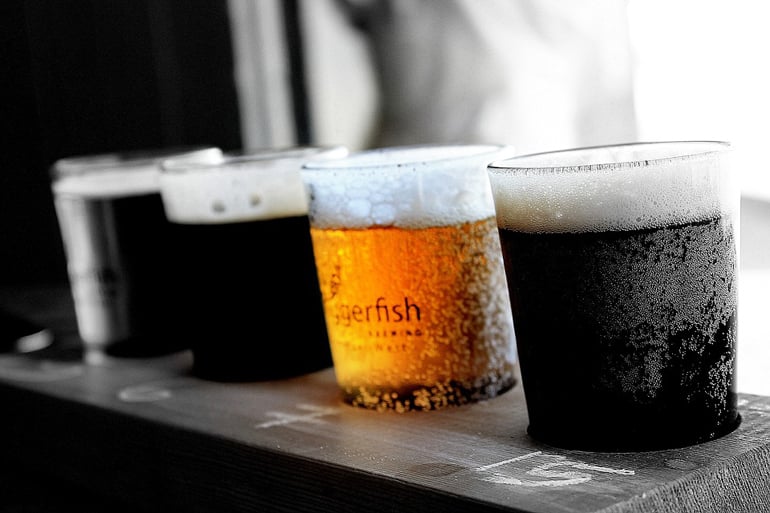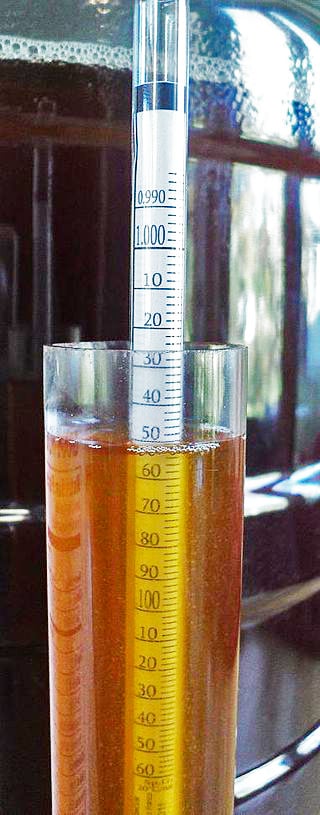Start 14-Day Trial Subscription
*No credit card required

What Is Original Gravity?
As Mythbusters' ballistics expert, Adam Savage, has said: "Remember kids, the only difference between screwing around and science is writing it down." During the brew day, one of the most important things to write down and one of the very last things to write down is Original Gravity. Original Gravity dictates whether the desired ABV will be achieved in a brew. It dictates whether the hop additions will provide the desired balance. It determines whether or not the brew day went as planned. Ultimately, it's a measure of how well the brewer knows their brewery. If you're interested in the role of science in brewing, Patrick Wadkins has some interesting articles you can read.
Gravity is a key measure in physics and petroleum as well as brewing and winemaking. In physics gravity is the force bringing objects together. In the contexts of petroleum and fermentation, gravity is the measure of a liquid's density relative to water at a specified temperature. Within brewing and winemaking, the difference in density is a result of dissolved, fermentable sugars. Each increment (1/1000th) on the specific gravity scale represents a .1 percent increase in density - a 1.100 specific reading indicates a wort that is 10 percent denser than water. Most 5 percent ABV beers have an original gravity around 1.050. Bigger beers like American Barleywines and Imperial Stouts can surpass 1.100 with smaller beers like an American Light Lager or Berliner Weisse rarely exceed 1.030.

The color of a beer can provide clues to its density. The higher the density of a beer, the higher its gravity will be.
Gravity measurements, or 'specific gravity readings' are made at key points throughout the wort-making and fermentation process; prior to boiling the wort ("pre-boil gravity"), immediately prior to pitching the yeast ("original gravity"), and post-fermentation ("final gravity"). These readings are usually taken with a floating hydrometer or refractometer. A hydrometer is a tall, thermometer-like glass instrument placed within the sample of the liquid to be measured. A refractometer is a monocular-like instrument with a glass prism where a drop of the sample liquid is placed. Hydrometers and refractometers expect the wort to be at a calibrated temperature – usually 65˚F. Calculations exist to adjust the readings taken at higher temperatures – though this is less of a concern with the refractometer because the sample size, a drop from a pipette, cools much faster than the 130 millileters of sample required by the hydrometer.
These dissolved, fermentable sugars were extracted from the beer recipe's grist – the barley, malt extract, adjuncts, or sugars – as part of the brewing process.The amount of sugars within a fermentable ingredient is measured in Points Per Pound Per Gallon (PPG), or the specific gravity reading from extracting 100 percent of the sugars of one pound of the fermentable within one gallon of water. Each ingredient has a different amount of available sugars; Liquid malt extract has 36 PPG, American 2-row barley has 28, wheat has 38. No all-grain brewhouse can extract all 100 percent of the fermentable sugars. Commercial breweries aim to extract 80 to 90 percent of the sugars where as many homebrew-scale recipe writers assume the homebrewer's system can achieve only 70 percent. A number of factors impact brewhouse efficiency and therefore impact the original gravity reading these include; the amount of sugars in the fermentables (total PPG), volume of each fermentable, the temperature rests of the mash schedule, mash pH, and total boil time.
Let's Get Technical
 A simple American Pale Ale recipe may include 9 pounds of 2-Row and .25 pounds of Crystal 40L. The 2-Row has a 37 PPG and the Crystal has a 34 PPG. On my homebrew system, I usually brew six gallon batches and average 70% efficiency. By multiplying each grain's PPG by the number of pounds used divided by the batch size in gallons (37*9/6=55.5 for the 2-Row and 34*.25/6=1.4 for the Crystal) the maximum gravity I could reach would be 55.5+1.4 = 56.9. Rounded and converted to a specific gravity reading gives us 1.057 Original Gravity. That's if 100 percent of the sugars were extracted. Multiplying the 57 by my 70 percent brewhouse efficiency gives us 39.9, or and expected original gravity of 1.040.
A simple American Pale Ale recipe may include 9 pounds of 2-Row and .25 pounds of Crystal 40L. The 2-Row has a 37 PPG and the Crystal has a 34 PPG. On my homebrew system, I usually brew six gallon batches and average 70% efficiency. By multiplying each grain's PPG by the number of pounds used divided by the batch size in gallons (37*9/6=55.5 for the 2-Row and 34*.25/6=1.4 for the Crystal) the maximum gravity I could reach would be 55.5+1.4 = 56.9. Rounded and converted to a specific gravity reading gives us 1.057 Original Gravity. That's if 100 percent of the sugars were extracted. Multiplying the 57 by my 70 percent brewhouse efficiency gives us 39.9, or and expected original gravity of 1.040.
The amount of sugars extracted stays constant (through PPG & efficiency), it's the volume of liquid changing the gravity. Which means, if I took a gravity reading at the end of the brew day and discovered I extracted more than 70 percent of the sugars. I could dilute the batch with more water bringing down the OG. If I extracted less than 70 percent, I could boil longer or add an easily dissolvable fermentable like honey (36 PPG) or corn sugar (46 PPG) at the end of a boil to achieve the target Original Gravity.
A brewer with the same recipe and an 85 percent efficiency could achieve the same 1.040 target OG with just 7.4# of 2-Row and 3.3oz of Crystal. Conversely, if they brewed with my 9 pounds and 4 ounces their 85 percent efficiency would result in a 1.048 OG. This substantial difference is why professional brewers talk in percentages - rather than pounds or kilograms - when describing a recipe, e.g. "97.3% American 2-Row, 2.7% American Crystal 40L, to 1.040 OG." This concisely describes the ratio of ingredients and target gravity, while leaving out the brewhouse-specific efficiency.




Comments